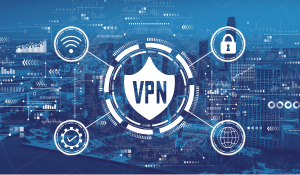Establish Clear Policies
Develop comprehensive BYOD policies outlining acceptable use, security protocols, and guidelines for employees.
4 min read
 DriveLock
Mar 11, 2024 3:29:41 PM
DriveLock
Mar 11, 2024 3:29:41 PM

In today's interconnected world, the concept of "Bring Your Own Device" (BYOD) has emerged as a popular trend in workplace culture. Empowering employees to utilize their personal devices, be it smartphones, tablets, or laptops, for work-related tasks, BYOD offers unparalleled flexibility and convenience. However, with this convenience comes a myriad of cybersecurity concerns that must be carefully addressed.
To secure company data, organizations must ensure that personal devices don't become a threat. This can involve requiring employees to install specific security software and follow rules of conduct for handling sensitive information.
The bring your own device trend offers benefits like increased productivity and employee satisfaction, but it also presents challenges in protecting data security and privacy.
| TABLE OF CONTENT |
As more organizations embrace the BYOD model to enhance productivity and employee satisfaction, it becomes imperative to navigate the intricate landscape of cybersecurity within the workplace. This blog post delves into the critical aspects of BYOD in cybersecurity, exploring the benefits, challenges, and essential strategies to safeguard sensitive data while embracing the BYOD phenomenon. Let's embark on a journey to understand how businesses can strike a balance between innovation and security in the age of BYOD.
Bring Your Own Device (BYOD) has become a popular practice in recent years, as businesses have recognized the benefits of allowing employees to use their personal electronic devices for work-related tasks. The rise of mobile technology has made it easier than ever for employees to access work materials, communicate with colleagues, and stay up-to-date on industry news and developments. BYOD is used in schools, universities and sometimes also in public authorities.
As technology advances, companies are increasingly adopting a "bring your own device" (BYOD) policy for their employees. This allows employees to use their personal devices, such as smartphones or laptops, for work purposes. However, it is important to note that the use of personal devices is entirely voluntary, and employees are not obligated to use them.
To uphold the security and privacy of the company's data, it is crucial to guarantee that personal devices do not put it at risk. In order to comply with security and data protection regulations, employees may be asked to install particular applications or software on their devices. This software serves to safeguard sensitive information and prevent unauthorized entry to the company's network.
In addition to software requirements, employees may also be given rules of conduct for using their personal devices for work purposes. This can include guidelines on how to handle sensitive information, such as not sharing work-related files on personal cloud storage accounts or not using public Wi-Fi networks to access company data.
Overall, the use of personal devices for work purposes can be a convenient and cost-effective solution for both users and companies. However, it is important to ensure that proper measures are in place to protect the security and privacy of the company's data. By implementing specific software and guidelines for employees, companies can safely and effectively adopt a BYOD policy.
The adoption of BYOD presents a potential threat to both data protection and the security of a company's IT infrastructure. This is because data can be stored and processed on personal devices not owned by the company. These personal devices can only be controlled to a certain extent, as they are often used in external networks and for personal applications.
As a result, users must follow security guidelines when using these devices. For instance, it is prohibited to store company data on external storage devices such as hard drives or USB sticks. Furthermore, specialized software can be installed on these devices to ensure compliance with security guidelines.
This software only allows the running of applications within a protected environment that utilizes encryption or blocks external connections. However, this may limit the personal use of these devices. From a data protection standpoint, it is crucial to keep company data separate from personal data. Compliance with the General Data Protection Regulation (GDPR) is essential in this regard.
The Bring Your Own Device (BYOD) trend has gained popularity in recent years as it enables employees to use their personal mobile devices for work rather than a company-issued device. Although BYOD has its benefits such as increased productivity and employee satisfaction, it also poses some challenges that organizations must overcome to ensure security and privacy of their data.
With the increasing trend of Bring Your Own Device (BYOD) in the workplace, it is important for organizations to establish best practices to ensure the security of confidential data. BYOD presents a unique challenge for cybersecurity as personal devices may not have the same level of security as company-issued ones.
Develop comprehensive BYOD policies outlining acceptable use, security protocols, and guidelines for employees.
Utilize MDM solutions to enforce security policies, monitor device activity, and remotely manage and wipe devices if necessary.
Mandate the installation of security software, including antivirus, anti-malware, and encryption tools.
Implement robust authentication methods, such as multi-factor authentication (MFA), to secure sensitive information.
Ensure the ability to remotely wipe company data from lost or stolen devices to prevent unauthorized access.
Hold users accountable for adhering to BYOD policies and guidelines, with consequences for non-compliance.
In conclusion, the integration of Bring Your Own Device (BYOD) policies into the workplace landscape presents both opportunities and challenges for businesses striving to enhance productivity and flexibility while maintaining robust cybersecurity measures. As the reliance on personal devices continues to grow, it becomes paramount for enterprises to adopt a proactive approach towards mitigating risks and safeguarding sensitive data.
In essence, the successful implementation of BYOD in the workplace requires a delicate balance between innovation and security. By prioritizing the protection of company data and fostering a culture of cybersecurity awareness among employees, businesses can confidently embrace BYOD as a strategic asset, empowering their workforce to thrive in today's dynamic digital landscape. Embracing BYOD isn't just about convenience; it's about embracing a new paradigm of productivity while safeguarding what matters most: your company's data.

With the proliferation of mobile devices in the workplace, securing endpoints is becoming increasingly complex. Companies need to find ways to ensure...

In today's rapidly evolving digital landscape, endpoint security stands as the frontline defense against a myriad of cyber threats. As organizations...

One of the key technologies that plays a decisive role in this is the Virtual Private Network (VPN). VPNs have become an indispensable tool in...